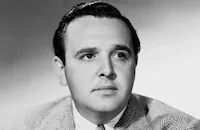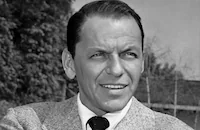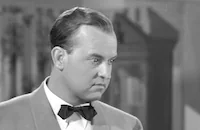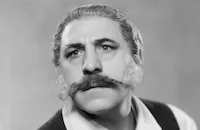Anchors Aweigh

Brief Synopsis
Cast & Crew
George Sidney
Frank Sinatra
Kathryn Grayson
Gene Kelly
José Iturbi
Dean Stockwell
Film Details
Technical Specs

Synopsis
After eight months at sea, sailors Clarence Doolittle and Joseph Brady are granted a four-day shore leave in Hollywood, California. Joe, an incorrigible philanderer, plans to see one of his sweethearts while on leave, and later offers the shy and bookish Clarence advice on how to meet women. Clarence and Joe set out to find their shore leave romances but their plans are soon thwarted by a police sergeant, who demands that they help him with an unusual situation involving a young boy named Donald Martin. The police sergeant explains that Donald has run away from home to join the Navy and refuses to tell the police where he lives. Joe and Clarence easily win Donald's trust and agree to escort him home, where he lives with his widowed aunt, Susan Abbott. While Joe is eager to avoid any further involvement with the young boy, Clarence falls in love with Susan and promises to return the following day. When Joe and Clarence return to Susan's, they meet Bertram Kraler, a man Susan hopes will introduce her to the famous maestro José Iturbi. As Susan dresses for her date, Joe, convinced that Bertram is a new suitor who will only get in the way of Clarence's romantic pursuit of Susan, scares Bertram away by suggesting that Susan is a notorious Navy sweetheart. When Susan learns what Joe has done, she breaks down in tears and believes that her chances at breaking into show business are doomed. Joe tries to comfort Susan but only makes matters worse for himself when he tells her that Clarence and Iturbi are good friends and that he can arrange an audition for her. With her faith in Joe and Clarence restored, Susan takes them to a Mexican restaurant and sings a song for them. While Joe dances with Susan, Clarence meets a friendly waitress, whom he nicknames "Brooklyn," after their hometown. Realizing that he must honor Joe's promise to Susan for an audition with Iturbi, Clarence tries unsuccessfully to meet with Iturbi at the Metro-Goldwyn-Mayer studios. Meanwhile, Joe, who has become quite fond of Donald and Susan, tells Donald's classmates a story about his experience in a mythical kingdom populated by animals: In the kingdom, Joe discovers that the animals that live there are sad because their mouse king has prohibited them from singing. Determined to help the animals, Joe visits their unhappy king and shows him the beauty of song and dance. Joe's story concludes with the king repealing his edict and allowing the animals to sing. As a new romance develops between Clarence and Brooklyn, Joe falls in love with Susan. One day, Susan has a chance encounter with Iturbi and discovers that Joe and Clarence have been deceiving her and do not really know Iturbi. Feeling embarrassed and betrayed, Susan breaks down in tears. Iturbi, however, understands her situation and arranges a screen test for her. The test is a great success, and Iturbi soon presents Susan at one of his shows. Before returning to his ship, Joe makes amends with Susan, and Clarence and Brooklyn embrace.

Director

George Sidney
Cast

Frank Sinatra

Kathryn Grayson

Gene Kelly

José Iturbi

Dean Stockwell

Pamela Britton

"rags" Ragland

Billy Gilbert

Henry O'neill
Carlos Ramirez

Edgar Kennedy

Grady Sutton

Leon Ames
Sharon Mcmanus

James Flavin

James Burke

Henry Armetta
Chester Clute
Alex Callam
Billy Nelson
Frank Mitchell
Allen Ray
Harry Barris
John James
Jerry Shane
John Cannon
Eddie Hall
Sam Finn

Wally Cassell
Douglas Cowan

Henry Daniell
Phil Hanna
William "bill" Phillips
Tom Trout
Arthur Walsh
Esther Michelson
Lottie Harrison
Frank Marlowe

Lee Phelps
Robert E. O'connor
Forbes Murray
William Forrest

Ray Teal
Milton Kibbee
Virginia Engels
Don Garner
Garry Owen

Steve Brodie
Paul Regan
Joe Haworth
Marjorie Wood
Jane Green
Claire Whitney
Netta Packer
Naomi Scher
Romere Darling
Connie Starr
Connie Montoya
Gloria Hope
Peggy Maley
Lester Dorr
Jack Luden
Bob Homans
Sondra Rodgers
Milton Parsons
Renie Riano
Jack Harvey
Joe Bernard
Paulita Arviza
Elinor Troy
Mimi Aguglia
Ben Heiderman
Joe Dominguez
Nolan Leary
Charles Coleman

Ralph Dunn
Frank Darien
J. Lockard Martin
James Carlisle
Ruth Lee
Thomas Quinn
Bea Nigro
Crew
Ray Austin
Vera Bloom
Charles Boyle
Johannes Brahms
Earl Brent
Earl Brent
Sammy Cahn
Jesus Castillón
Mark Davis
Jack Dawn
Kay Dean
Peter P. Decker
B. G. Desylva
Jack Donohue
Randall Duell
Adrienne Fazan
Oscar Felix
James Z. Flaster
Chet Forrest
Rudolf Friml
Jacob Gade
Cedric Gibbons
Irving Glassberg
Henri Jamblam Herpin
Irene
Henri Jaffa
Natalie Kalmus
Gene Kelly
Standish J. Lambert
Isobel Lennart
Lamberto Leyva
Franz Liszt
R. Lovell
Jay Marchant
Freddy Martin
M. J. Mclaughlin
Joseph Meyer
Alfred Hart Miles
Warren Newcombe
Joe Pasternak
Richard Pefferle
Robert Planck
Carol Raven
George Rhein
Thomas Richards
Matos Rodriguez
Harold Rome
Gioacchino Antonio Rossini
William J. Saracino
Douglas Shearer
Robert W. Shirley
Newell Sparks
Herbert Stahlberg
William Steinkamp
Michael Steinore
Cesare Sterbini
Georgie Stoll
Axel Stordahl
Jule Styne
Peter Ilyich Tchaikovsky
John A. Williams
Edwin B. Willis
Bobby Worth
Bob Wright
Charles A. Zimmerman

Photo Collections
Videos
Movie Clip




Trailer
Hosted Intro





Film Details
Technical Specs

Award Wins
Best Music Original Dramatic Score
Award Nominations
Best Actor
Best Cinematography
Best Picture
Best Song
Articles
Anchors Aweigh - Anchors Aweigh
Aside from the spectacular Technicolor (whose radiant bright hues turned Southern California into a kaleidoscopic paradise), Anchors Aweigh was expertly helmed by George Sidney, beginning his feature film tenure after apprenticing in the studio's shorts department. Sinatra, never one to forget a key player in his career, heartily approved when Sidney was slated to direct Pal Joey in 1957.
Of course Gene Kelly was no slouch either - nor was female lead Kathryn Grayson or the cute little urchin playing her kid brother, Dean Stockwell. Kelly's imaginative dances, resulting in the masterful live action/animation set piece, wherein the star cuts a veritable rug with MGM's cartoon luminary Jerry the Mouse, is probably the most famous sequence in the picture.
In The Films of Gene Kelly by Tony Thomas, Kelly recalls the origin of this dance which took two months to complete: "Stanley Donen and I sat around for a couple of days trying to think of something and after one long period of silence Stanley suggested, "How about doing a dance with a cartoon?" This was it. The MGM brass didn't think it could be done, but [producer Joe] Pasternak went to bat for us and got a budget of $100,000, to do it as an independent production, warning us that it likely would not appear in the movie. Stanley and I went to Walt Disney, to get his advice and possibly hire some of his men to work for us. But this wasn't possible because the Disney studio was so busy it couldn't accept any extra work. Disney was himself experimenting with live action and animation at that time although he had nothing as difficult in mind as what we hoped to do. But he gave us his blessings, and the fact that Disney considered the idea feasible helped us persuade the MGM cartoon department to do the job. I get all the credit for this, but it would have been impossible for me without Stanley, he worked with the cameraman and called the shots in all these intricate timings and movements. It wasn't easy for the cameraman - he was being asked to photograph something that wasn't there."
Indeed, the Jerry the Mouse/Gene Kelly dance is a unique novelty but it is probably the magnificent Jule Styne/Sammy Cahn songs (including "What Makes the Sunset" and "I Begged Her") that the flick's legions of fans take closest to heart. A top favorite is "I Fall in Love Too Easily"; as sung by a lonely Sinatra in the empty Hollywood Bowl, the ballad, in its elegant simplicity, remains one of the movie musical's greatest moments.
Director: George Sidney
Producer: Joe Pasternak
Screenplay: Isobel Lennart, Natalie Marcin
Cinematography: Robert Planck, Charles Boyle
Editor: Adrienne Fazan
Art Direction: Cedric Gibbons, Randall Duell
Music: George Stoll, Jule Styne, Sammy Cahn
Cast: Frank Sinatra (Clarence Doolittle), Kathryn Grayson (Susan Abbott), Gene Kelly (Joseph Brady), Jose Iturbi (Himself), Dean Stockwell (Donald Martin), Rags Ragland (Police Sergeant).
C-140m. Close captioning.
by Mel Neuhaus

Anchors Aweigh - Anchors Aweigh
Quotes
Trivia
For the most famous sequence in the film, Mickey Mouse was originally meant to be 'Kelly, Gene' 's dance partner. However, when Walt Disney refused to have his most famous character appear in an MGM film, Kelly turned to MGM's own animation studio and used Jerry Mouse of Tom and Jerry fame.
When the dance sequence with 'Kelly, Gene' and Jerry the Mouse was screened for MGM executives, someone noticed that although Gene Kelly's reflection shone on the floor during his dancing, Jerry's did not. So all the animators who worked on the sequence had to be rehired to go back in and draw Jerry's reflection on the floor as he was dancing.
Notes
Anchors Aweigh marked Frank Sinatra's first film under his new contract with M-G-M, following his departure from RKO, and his motion picture dancing debut. Gene Kelly began his service in the Navy a short time after the film was completed. An October 1943 Hollywood Reporter news item notes that Eleanor Powell was originally set for the female lead, and that M-G-M later cast Marilyn Maxwell in the role. The same news item indicates that Jackie "Butch" Jenkins, Nancy Walker and Ben Blue were originally set for roles. According to an April 1944 Hollywood Reporter news item, Ann Miller was considered for a dancing role opposite Kelly. Various news items in Hollywood Reporter in 1943 and 1944 indicate that Jack Haley, Keye Luke and Phil Silvers were considered for roles, but they did not appear in the released film. Although their appearance in the final film has not been confirmed, contemporary news items and Hollywood Reporter production charts include the following actors in the cast: Jack Lambert, Ella Logan, Dean Murphy, January Gilbreath and Peter Whitehead. A December 1944 Hollywood Reporter news item noted that Sara Berner "completed recording" on the film. Berner, a cartoon voice specialist, May have provided the voice of "Jerry the Mouse." Modern sources note that Sinatra's role was originally intended for actor Eddie Bracken, and that Elizabeth Taylor was considered for a starring role.
The cartoon sequence in which Kelly enters a mythical kingdom is frequently shown in documentaries about film and film musicals. The experimental technique of combining live action with animation had been used since the 1920s but had not been used extensively until the 1945 Disney film The Three Caballeros (see below). The cartoon mouse featured in the Anchors Away sequence is "Jerry the Mouse" of the Tom and Jerry cartoon series. According to a December 1944 Hollywood Reporter news item, M-G-M formed a new cartoon unit of animators, writers and other specialists to handle the extra footage for the live-action and animation sequence. Modern sources note that Fred Quimby was one of the animators of the cartoon sequence, and that M-G-M had initially sought permission to use "Mickey Mouse" for the part of the mouse king. Disney, however, refused to allow "Mickey" to be used in the film. A biography of choreographer/director Stanley Donen indicates that Donen spent one year working on the "Jerry the Mouse" sequence, and that the picture was held from release until the sequence was completed.
Hollywood Reporter production charts and a July 1944 Hollywood Reporter news item lists Thomas Richards as the film's editor, but only Adrienne Fazan is credited onscreen. In a 1947 interview, composer Jule Styne stated that the song "The Charm of You," which Sinatra sang to Pamela Britton in the film, was originally intended to be sung to Kathryn Grayson. The five songs composed by Styne and Sammy Cahn were written especially for the film. In addition to the songs listed above in Songs, the film contains an unidentified tango composed by Carmen Dragon, according to the Variety review. A 1944 Hollywood Reporter news item noted that twenty-three musical numbers had been completed for the film. Musical numbers that were considered or recorded and that were not used in the final film include: "It Could Only Happen in Brooklyn," a duet planned for Sinatra and Britton, composed by Styne and Cahn; "I'll Be Waiting Here," a song planned for Britton, composed by Earl Brent; "Caro nome," from the opera Rigoletto by Giuseppe Verdi, and a selection from the opera Lucia di Lammermoor by Gaetano Donizetti, to be sung by Grayson; "Another Kiss," composed by B. G. DeSylva and Ted Grouya, to be sung by Sinatra and Grayson; "Loveland" by Hugh Martin and Ralph Blane; "The Kid That I've Never Seen" by Herman Ruby, Bert Kalmar, Al Jolson and Harry Akst; "My Follies Girl," by Jolson and Akst; and "As I Recall," "When I Get to Town," "Love and I Went Waltzing" and "Don't Be Subtle, Don't Be Coy" by Styne and Cahn.
Some filming took place on location at the Hollywood Bowl, in Los Angeles, CA CA, and at the U.S. Naval Academy at Annapolis, MD. Sinatra, Grayson and Kelly recreated their roles for a Lux Radio Theatre broadcast of the story, which aired on December 29, 1947. A Hollywood Reporter news item in January 1946 indicates that M-G-M planned a sequel to Anchors Aweigh entitled All Ashore, written by Columbia Pictures producer Robert Taplinger. The sequel was to reteam Sinatra, Kelly and Grayson under the direction of George Sidney. Although All Ashore was shelved in September 1946, a film bearing the same title, and with a similar story, was released by Columbia in 1952. The 1952 film was directed by Richard Quine and starred Mickey Rooney and Dick Haymes.
Anchors Aweigh received an Academy Award for Best Scoring of a Musical Picture, and was nominated for awards for Best Picture, Best Actor (Gene Kelly), Best Cinematography and Best Song ("I Fall in Love Too Easily").















